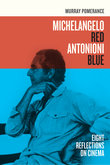Writing about Michelangelo Antonioni is like trying to catch air. There is material in abundance, but it is difficult to quantify and marshal. But, with Michelangelo Red Antonioni Blue, Murray Pomerance has made an effective job of accounting, meaningfully, for the colour films of the late Italian director. This work is systematic, but it is also imbued with great feeling. Without doubt, Michelangelo Red satisfies Pomerance’s stated desire to “find … the song of the films”.
The emphasis on Antonioni’s colour work is stated in the short introduction. Palpably, Antonioni saw colour as a fundamental element of cinema, the ultimate means of displaying the world and, moreover, our interpretations of it. In like spirit, Pomerance asserts that film colours offer “more than facts, more than indications” (x) and it follows that Antonioni’s colour films should be regarded as his signature pieces.
Thus, we are guided through analyses of the eight films, beginning with Beyond the Clouds (1995) and ending with Blow-up (1966). The non-chronological sequencing of the chapters is never explained, but, like many things in the book, it seems intended to evoke the approach of the director (for whom time was just one consideration amongst many). Rightly, Blow-up does appear as a culmination of sorts, the moment where Antonioni nailed this modern world of appearances, but Pomerance identifies key concerns in every work. As befits the auteur, some of these recur in other films.
Three themes appear to stand out in Antionioni’s oeuvre, to do with: conditions of modernity; knowledge (self-knowledge included) and nature. Pomerance informs us that certain films – notably Beyond the Clouds, Blow-up, Zabriskie Point (1970) and The Dangerous Thread of Things (2004) – demonstrated the transience of relationships and things in modern life. Their bold palette also helped to emphasise the hyperreal appearance of our constructed environments. Clearly, Pomerance prefers to think of hyperreality as a modernist trait and not postmodernist; nonetheless, Antonioni’s films are marked by their scepticism about objective truths. Pomerance details the director’s dismissive attitude towards science (Identification of a Woman, 1982), but this is framed within an understanding that human beings can never uncover objective truths and so must rely on an “apprehension of surfaces” (43). Inevitably, this leads Pomerance to dwell upon Antonioni’s obsession with notions of identity. In particular, the confident analysis of The Passenger (1975) affirms Pomerance’s general sense of the “provisional nature of identity [in Antonioni’s work] and the substantial nature of being” (207). In turn, nature itself – the supposed ‘natural world’ – is treated in ambiguous fashion by Antonioni. If Zabriskie Point offers a promising “primaeval desert which still keeps the form of its origins” (165), Antonioni is careful, here and elsewhere, to suggest the points of continuity between natural and built worlds. Rightly, Pomerance sees the industrial landscapes of Red Desert (1964) as being ugly (‘awkward’) yet “pretechnological, precapitalist … beautiful … gracile” (70).
As the above quote suggests, Pomerance’s book is blessed by some delicate phrases. These range from the profound (“A film can enter us and reside there”, 5) to the quietly humorous (“No one who can be a movie star or a heart surgeon stoops to being a teacher”, 113). The clever lines and everyday references are never gratuitous; rather, they engage, sensitively, with Antonioni’s cinema of life. The same might be said of Pomerance’s wide range of references. Of course film writers are referenced, including other critics of Antonioni, but, additionally Antonioni Red takes in sources from the fields of: philosophy (Foucault, Benjamin, Simmel, Sartre, Schieler), social history (Sebald), ethnomethodology (Garfinkel), literature (Hammett, Orwell, Shakespeare, Eliot, Joyce) and art (Matisse, Guercino). Such catholic references are joined, over time, by helpful interjections from Antonioini collaborators, including the actors Ronan O’Casey and Daria Halprin, production designer Dean Tavoularis and assistant director Bob Rubin. To his great credit, Pomerance makes seamless use of his highly detailed research.
Unquestionably, there is much to admire in Michelangelo Red Antonioni Blue, but I do not find it to be flawless. The writing is evocative on many occasions, but it is also dense at times. Pomerance has a disquieting habit of beginning huge sentences on subordinate clauses – he also has a penchant for lengthy parenthetical clauses. These vices (as I see them) combine on Pages 111-112 to create a sentence of 187 words. I am certain that such moments are intended to mirror Antonioni’s sinuous style, but they are tortuous at points. I also think that Pomerance’s work sometimes errs towards hagiography. On Page 4, Pomerance recalls Agee’s description of the true auteur (said of Chaplin’s Monsieur Verdoux): “[it is] a definitive measure of what a man of genius places before the world and things the world is equipped to see in it” (4). In other words, the critic is king and we all should all listen up. More importantly, Agee’s idea encourages a lack of critical distance on the part of the critic and this happens, on occasion, in Antonioni Red. Every film is taken to be the natural effusion of Pomerance’s ‘man of genius’ and he is notably hostile towards Antonioni’s critics – the opponents of Zabriskie Point receive particularly short shrift.
Nonetheless, I like and admire this book. Pomerance expresses a strong connection to his subject and he is not afraid to express his own personal relationship with the films. (I am not surprised that Pomerance dreamt of Antonioni on the night of his death). Michelangelo Red Antonioni Blue also has much to tell us about life away from Antonioni. The reflections on art, nature, politics and so forth are sincerely meant. In addition, Pomerance produces some pertinent thoughts on the function of the film critic. He writes that “… our challenge is to understand how all its [the film’s] aspects cohere … into a statement that might not at first be intelligible to our limited reception” (49). This is a noble ideal and it is one which Pomerance meets – to telling effect.

